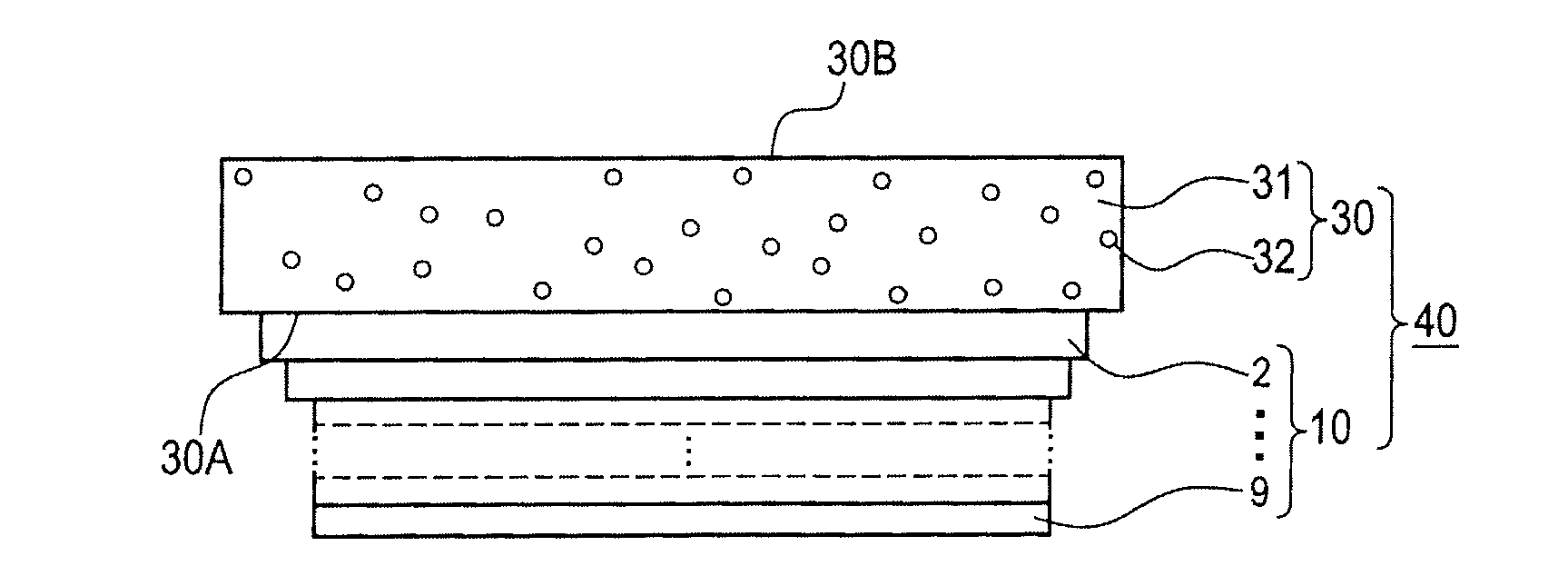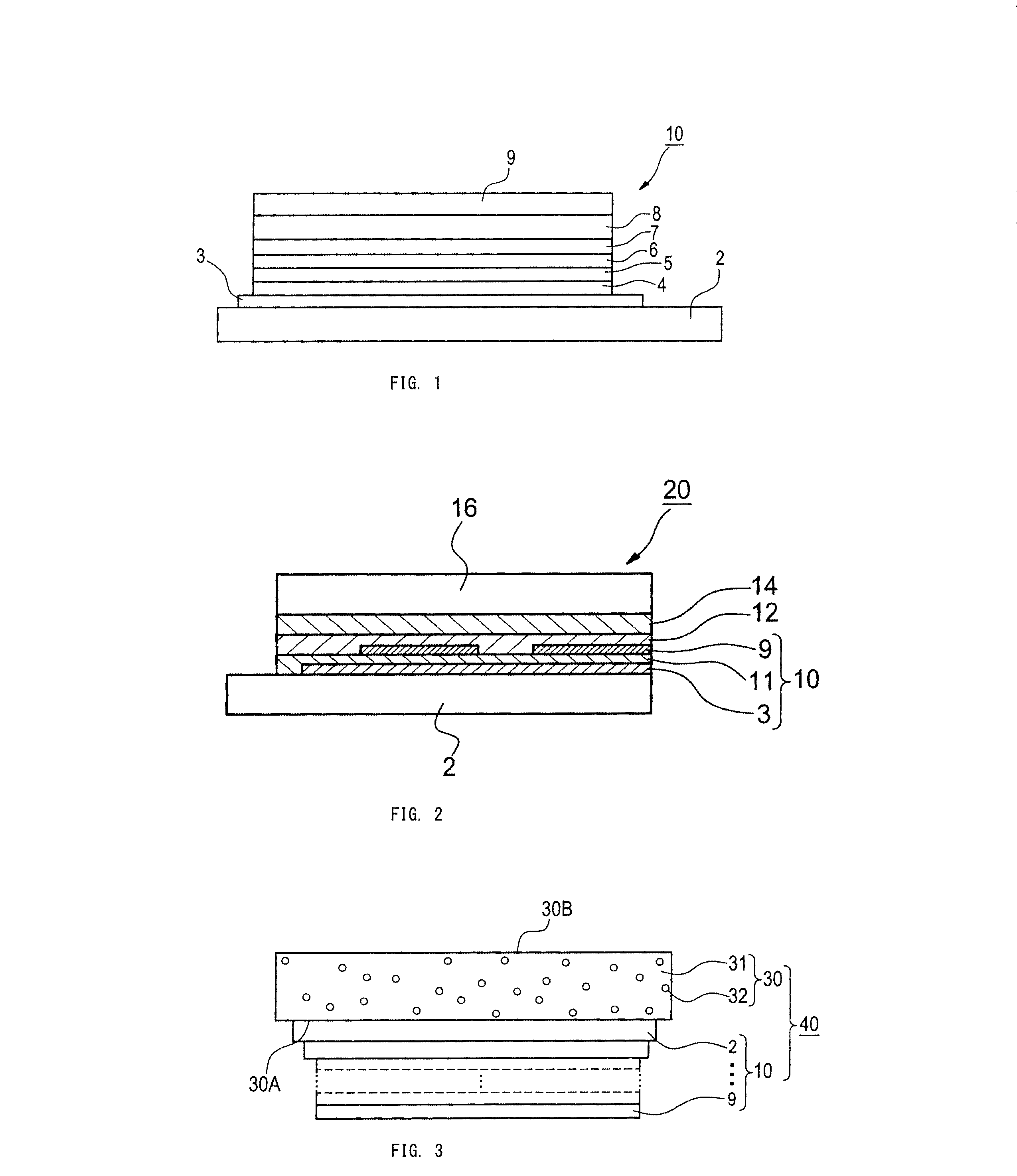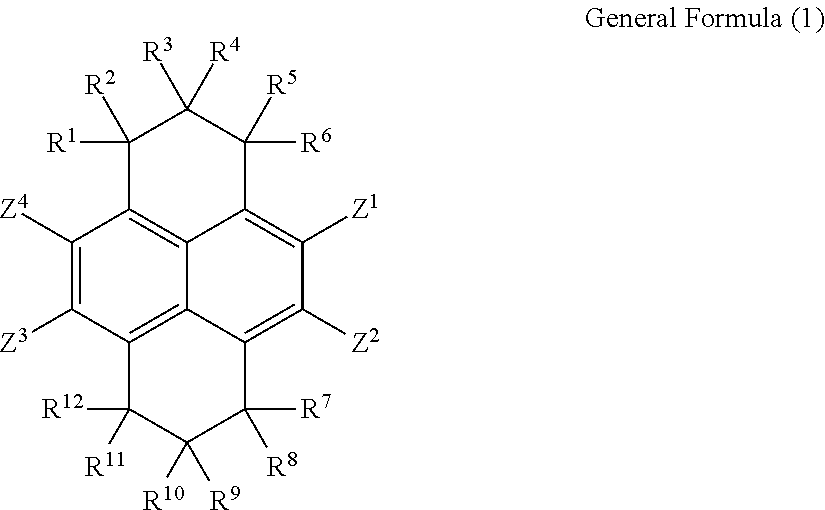Organic Electroluminescent Element, Material for Organic Electroluminescent Element, and Light Emitting Device, Display Device and Illumination Device Each Using the Element
a technology of electroluminescent elements and materials, applied in the direction of organic semiconductor devices, thermoelectric devices, organic chemistry, etc., can solve the problems of increasing crystallinity, achieve high blue color purity, improve chromaticity change reduction, and enhance luminous efficiency
- Summary
- Abstract
- Description
- Claims
- Application Information
AI Technical Summary
Benefits of technology
Problems solved by technology
Method used
Image
Examples
synthesis example 1
1. Synthesis Example 1
(Synthesis of Compound 1)
[0309]
(Synthesis of Compound 1a)
[0310]To a dichloromethane solution (500 mL) of 50 g of 1,2,3,6,7,8-hexahydropyrene (manufactured by ALDRICH), bromine (26 mL) was added dropwise at room temperature and stirred for 4 hours. A deposited crystal was filtered and washed with ethanol and hexane, thereby obtaining Compound 1a (39 g).
(Synthesis of Compound 1b)
[0311]An NMP solution (850 mL) of Compound 1a (29 g), N-(4-chloro-3-hydroxyphenyl)acetamide (38 g), dipivaloylmethane (manufactured by Tokyo Chemical Industry Co., Ltd.) (2.9 g), copper(I) chloride (16 g), and cesium carbonate (128 g) was stirred in a nitrogen atmosphere at 150° C. for 12 hours. The reaction solution was filtered with Celite, toluene / water was added to the filtrate, and the mixture was subjected to a liquid separation operation. The organic layer was washed with saturated salt water, dried over magnesium sulfate, and then concentrated under reduced pressure. The concentra...
example 1
Fabrication of Organic Electroluminescent Element by Means of Deposition
[0322]A 0.5 mm-thick and 2.5 cm square glass substrate (manufactured by Geomatec Co., Ltd., surface resistance: 10Ω / □) having an ITO film thereon was put in a cleaning container. After ultrasonic cleaning in 2-propanol, the glass substrate was subjected to a UV-ozone treatment for 30 minutes. The following organic compound layers were deposited sequentially on this transparent anode (ITO film) by a vacuum deposition method. Incidentally, the deposition rate in the following Examples and Comparative Examples is 0.1 nm / sec unless otherwise specifically indicated. The deposition rate was measured using a quartz oscillator. In addition, the thickness of each of the following layers was measured using a quartz oscillator.
[0323]First layer: HAT-CN: Film thickness: 10 nm
[0324]Second layer: HT-2: Film thickness: 30 nm
[0325]Third layer: H-1 and light emitting material (mass ratio: 93 / 7) shown in Table1: Film thickness: 3...
example 2
[0338]Organic electroluminescent elements were fabricated in the same manner as that in Example 1, except that the layer configuration was changed to one shown below, and the evaluations were made in the same manners as those in Example 1. The results are shown in Table 3. Incidentally, the external quantum efficiency shown in Table 3 is shown as a relative value while taking the external quantum efficiency of the organic electroluminescent element using the Comparative Material 1 as 1.0.
[0339]First layer: HT-4: Film thickness: 50 nm
[0340]Second layer: HT-3: Film thickness: 45 nm
[0341]Third layer: H-2 and light emitting material (mass ratio: 95 / 5) shown in Table 1: Film thickness: 25 nm
[0342]Fourth layer: ET-5: Film thickness: 5 nm
Fifth layer: ET-3: Film thickness: 20 nm
TABLE 3RelativeexternalChromaticityLight emittingquantumafter drivingElement No.materialefficiencyChromaticitydeteriorationNoteElement 2-1Compound 11.4◯◯The presentinventionElement 2-2Compound 21.3◯◯The presentinvent...
PUM
 Login to View More
Login to View More Abstract
Description
Claims
Application Information
 Login to View More
Login to View More - R&D
- Intellectual Property
- Life Sciences
- Materials
- Tech Scout
- Unparalleled Data Quality
- Higher Quality Content
- 60% Fewer Hallucinations
Browse by: Latest US Patents, China's latest patents, Technical Efficacy Thesaurus, Application Domain, Technology Topic, Popular Technical Reports.
© 2025 PatSnap. All rights reserved.Legal|Privacy policy|Modern Slavery Act Transparency Statement|Sitemap|About US| Contact US: help@patsnap.com



